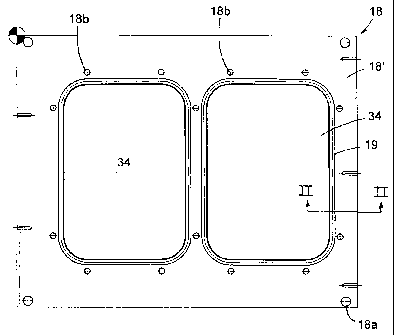Some of the information on this Web page has been provided by external sources. The Government of Canada is not responsible for the accuracy, reliability or currency of the information supplied by external sources. Users wishing to rely upon this information should consult directly with the source of the information. Content provided by external sources is not subject to official languages, privacy and accessibility requirements.
Any discrepancies in the text and image of the Claims and Abstract are due to differing posting times. Text of the Claims and Abstract are posted:
| (12) Patent: | (11) CA 2235266 |
|---|---|
| (54) English Title: | TRAY SEALING PLATEN AND SEAL APPARATUS |
| (54) French Title: | SUPPORT PLAT POUR GARNITURE D'ETANCHEITE DE PLATEAU RECIPIENT ET SERTISSEUSE |
| Status: | Term Expired - Post Grant Beyond Limit |
| (51) International Patent Classification (IPC): |
|
|---|---|
| (72) Inventors : |
|
| (73) Owners : |
|
| (71) Applicants : |
|
| (74) Agent: | BORDEN LADNER GERVAIS LLP |
| (74) Associate agent: | |
| (45) Issued: | 2005-03-29 |
| (22) Filed Date: | 1998-05-19 |
| (41) Open to Public Inspection: | 1998-12-02 |
| Examination requested: | 1999-05-28 |
| Availability of licence: | N/A |
| Dedicated to the Public: | N/A |
| (25) Language of filing: | English |
| Patent Cooperation Treaty (PCT): | No |
|---|
| (30) Application Priority Data: | ||||||
|---|---|---|---|---|---|---|
|
A peripheral resilient seal, and seal and platen, the platen having a container tray receiving cavity and a peripheral groove around the cavity and receiving the seal. The seal has side ribs deformable upon insertion into the groove, and a shoulder extending beyond the groove to abut the platen.
Joint élastique périphérique, joint et support plat, le support plat comportant une cavité de logement de plateau récipient et une rainure périphérique entourant la cavité et logeant le joint. Le joint comporte des nervures latérales déformables lors de l'insertion dans la rainure, et un épaulement s'étendant au-delà de la rainure pour buter contre le support plat.
Note: Claims are shown in the official language in which they were submitted.
Note: Descriptions are shown in the official language in which they were submitted.

2024-08-01:As part of the Next Generation Patents (NGP) transition, the Canadian Patents Database (CPD) now contains a more detailed Event History, which replicates the Event Log of our new back-office solution.
Please note that "Inactive:" events refers to events no longer in use in our new back-office solution.
For a clearer understanding of the status of the application/patent presented on this page, the site Disclaimer , as well as the definitions for Patent , Event History , Maintenance Fee and Payment History should be consulted.
| Description | Date |
|---|---|
| Inactive: Expired (new Act pat) | 2018-05-19 |
| Letter Sent | 2010-12-06 |
| Inactive: IPC from MCD | 2006-03-12 |
| Grant by Issuance | 2005-03-29 |
| Inactive: Cover page published | 2005-03-28 |
| Inactive: Final fee received | 2005-01-14 |
| Pre-grant | 2005-01-14 |
| Notice of Allowance is Issued | 2004-07-28 |
| Letter Sent | 2004-07-28 |
| Notice of Allowance is Issued | 2004-07-28 |
| Inactive: Approved for allowance (AFA) | 2004-07-12 |
| Amendment Received - Voluntary Amendment | 2004-01-21 |
| Inactive: S.30(2) Rules - Examiner requisition | 2003-08-19 |
| Letter Sent | 1999-06-16 |
| Amendment Received - Voluntary Amendment | 1999-06-14 |
| Request for Examination Requirements Determined Compliant | 1999-05-28 |
| All Requirements for Examination Determined Compliant | 1999-05-28 |
| Request for Examination Received | 1999-05-28 |
| Application Published (Open to Public Inspection) | 1998-12-02 |
| Inactive: IPC assigned | 1998-07-24 |
| Inactive: IPC assigned | 1998-07-24 |
| Inactive: First IPC assigned | 1998-07-24 |
| Classification Modified | 1998-07-24 |
| Filing Requirements Determined Compliant | 1998-06-29 |
| Inactive: Filing certificate - No RFE (English) | 1998-06-29 |
| Inactive: Applicant deleted | 1998-06-26 |
| Application Received - Regular National | 1998-06-26 |
There is no abandonment history.
The last payment was received on 2004-03-26
Note : If the full payment has not been received on or before the date indicated, a further fee may be required which may be one of the following
Please refer to the CIPO Patent Fees web page to see all current fee amounts.
Note: Records showing the ownership history in alphabetical order.
| Current Owners on Record |
|---|
| OLIVER PACKAGING AND EQUIPMENT COMPANY |
| Past Owners on Record |
|---|
| PERRY R. DEYOUNG |